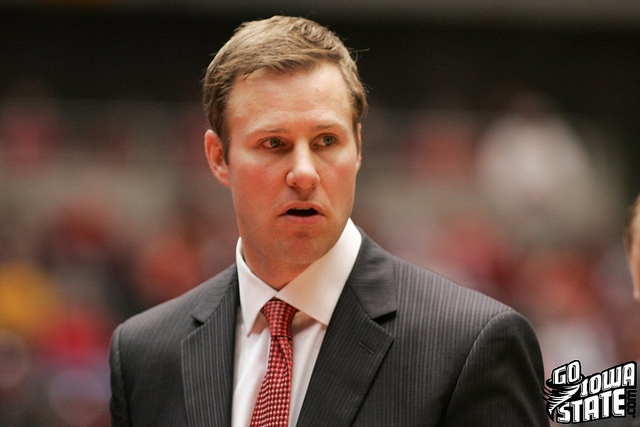By Kirk Haaland of enCYCLONEpedia.com Follow Kirk on Twitter @Khaal53
Sometimes it takes the just right situation to combine with the just right time to blow the lid off of a common practice; such is the case with Bo Ryan, Jarrod Uthoff and Wisconsin. A coach barring players from going to certain schools upon transferring isn’t a new practice but in this instance, the coach appears to be taking it too far and everyone is taking notice.
The hypocrisy has been outlined steadily and consistently among the national media where once again, the NCAA is caught in a pickle between are the players in fact amateurs and “student-athletes” or are they a part of a business model where these barred transfers are essentially non-compete clauses?
But, I won’t even dive in to that pool today and yes, I understand how my stance will be associated with the school that I cheer for while they have been in the headlines for their successes of bringing in transfers.
For the past few years Jeff Goodman of CBSSports.com has published an official list of all of the Division 1 men’s college basketball players that have elected to transfer at the season’s end. This year the list was up to 325 as of April 10th.
A staggering number for sure but is it that staggering when you consider there are 345 Division 1 teams? Probably so, but the average of one per team doesn’t exactly floor me.
Upon one of the original releases of his list via Twitter, Goodman added that “something had to be done”.
Why? Why does something need to be done? Why should a kid that signs a one year scholarship be required to jump through hoops to transfer, be punished for wanting to transfer, or have to face the negative stigma that is common.
The current rule for transfers is that they can move to a new school but have to sit out a year barring an NCAA waiver that are seemingly rarely granted. In Uthoff’s case, he could still transfer to an Iowa State, Marquette, or any ACC school but he would have to be a walk-on in his first year and pay his own tuition prior to being put on scholarship. That would leave him with three years of eligibility. Or, he could go to a junior college for next season and then transfer wherever he pleases and still be left with three years to play.
The requirement to sit out a year for a transfer is often times deemed to be as “not a strong enough of a punishment” or not “a strong deterrent”. Why should either of these be necessary in the first place?
I am okay with the rule as it is while it still is unfair to the player. It, like many things in life, is a way to try and eliminate gray areas by making everything white and black. The transfers could be a mockery if you could transfer freely from year to year and play at four schools in four years, but that is an extreme case.
Should Jarrod Uthoff, if he only has the urge to transfer one time in his collegiate career, be “punished” or “deterred” simply because he is unhappy with his situation or thinks the grass may be greener elsewhere?
But that issue is secondary to my biggest complaint.
My bigger problem is the power of a coach of an outgoing player to be able to limit a player’s destinations. I can live with stiffer rules for players that one to hop from team to another within the same conference but why should a coach be allowed to dictate a kid’s future when his new team will never be met while the player is still eligible, except for perhaps the NCAA or some other tournament?
Tampering, you say? Ahhh, yes. That is a serious issue and a serious defense must be used by coaches who have players that are tampered with by other programs. Banning certain destinations is often the only recourse for a coach with an exiting player.
But the problem doesn’t lay there. The problem lies with a school/coach being able to restrict schools arbitrarily under the guise of tampering. Sure, it may be going on but there has to be some burden of proof. Not proof without a shadow of a doubt, but enough to have plausible suspicion.
What about the Wes Johnson situation? The one where Wes decided to leave but was limited to just eight schools that he could transfer to by Iowa State and Greg McDermott. Again, the tampering claims and rumors were strong here but a burden of proof should still be necessary.
But let’s look at the signs of that case versus the Uthoff case. Wes Johnson decided to leave on May 19, 2008. That was more than a full month later on the calendar than when Uthoff made his decision. Johnson had just signed his scholarship papers for the next season and his lease for a place to live, and then he decided to leave just a few weeks later.
The other key component of that situation that was much different? While Wes Johnson only had eight schools to choose from, he never appealed that. Draw your own conclusions as to why that may have been.
To make a long story short, the Uthoff scenario does not equal the Wes Johnson scenario.
But many people are right that something does need to be done. The first thing is for everyone to fix their perception that a kid transferring is inherently negative. Schools/coaches wanting to ban certain transfer destinations should have some burden of proof with tampering allegations. Perhaps the “student-athletes” should be granted one free transfer where they don’t have to sit out a year?
Times change and I know what old school and my parents’ generation is saying, “no one can honor a commitment anymore.” While that sentiment is partially true, the 18-22 year old kids that are trying to do the best they can for their situation are not much of a match for experienced coaches in their 50’s or BCS level institutions.
Athletes have four to five years to make the most of their college eligibility before their time is up. Having to deal with spiteful, petty and vindictive behavior from their soon to be former coaches shouldn’t be yet another road block in making that happen. The fact is that the coaches and players are playing with a different set of rules and that something does need to change. But the change that is needed isn’t ramping up the punishment and deterrent even more for the players.





